Photos with this report (click to enlarge) | |||
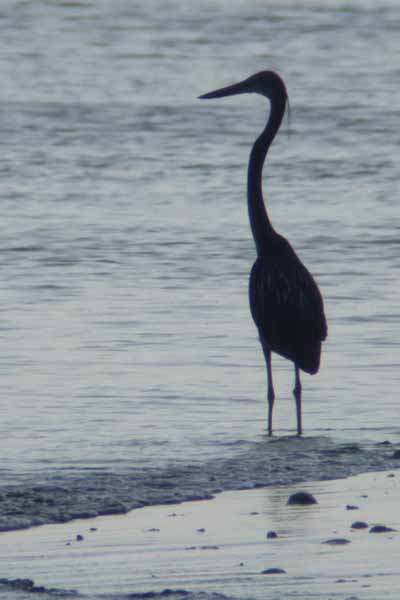 Great-billed Heron |
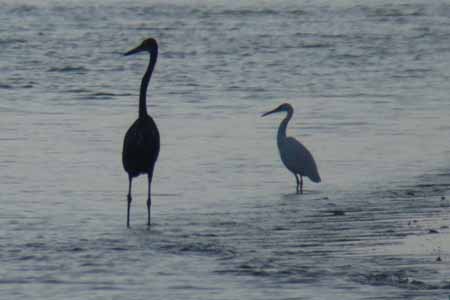 Great-billed Heron |
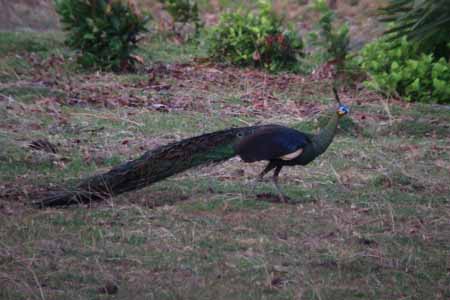 Green Peafowl |
|
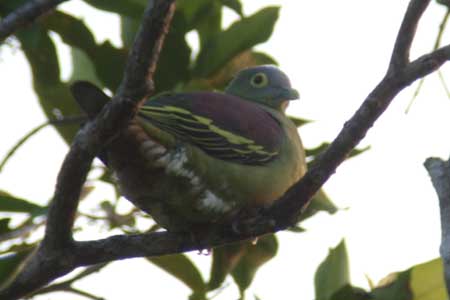 Grey-cheeked Green-Pigeon |
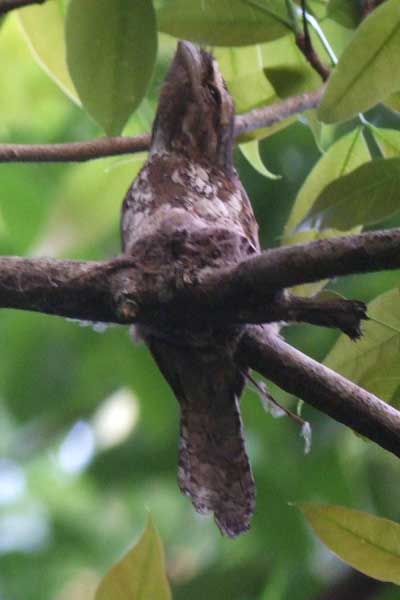 Javan Frogmouth |
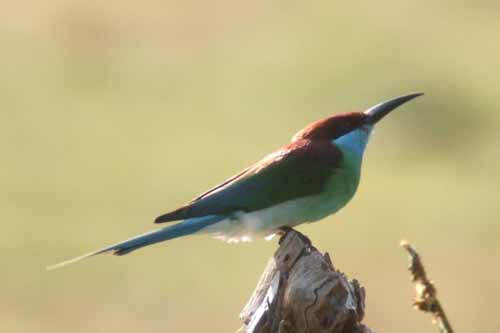 Blue-throated Bee-eater |
|
This short trip report covers a birding trip to several sites in western Java, made in July 2012. This was prior to a two week visit to Sumatra and provided a great warm-up to that trip. Java has shares a number of Sundaic endemics only with Sumatra (some of which are rather harder to find on the latter) but also has a significant number of Javan endemics, a large majority of which are easily found at one montane site (Gede-Pangrango). Western Java also has the benefit, in a relatively small area, of a good array of other habitats, all also readily accessible from Jakarta: as well as Gede-Pangrango, we visited Bogor Botanical Gardens (directly en-route to Gede), Carita (degraded lowland coastal forest), the more remote (and far more splendid) Ujong-Kulon National Park (doesn’t seem to feature in many trip reports, but easy to visit from Carita if you have 3-4 days to spare; far, far higher quality lowland forest than Carita, plus empty beaches, grasslands and river trips) and Pulau Dua, an area of coastal fish ponds and mangroves on the north coast en-route between Jakarta and Merak / Carita. From Carita, it is also easy to make a trip to the incomparable Krakatau, easily the non-birding highlight of any trip western Java.
What to bring
For books there is no choice but to use the so-so Mackinnon and Phillipps Field Guide to the Birds of Borneo, Sumatra, Java and Bali which, despite many limitations, is still ok most of the time, although one or two trip reports with systematic lists outlining updated taxonomic changes are useful supplementary material. In addition, Robson’s Field Guide to the Birds of South-east Asia is also pretty good for many of the trickier species (and even more useful in Sumatra); Paul Jepson’s Birding Indonesia (Periplus, 1997 – maybe not in print anymore?) is also excellent and still highly relevant and applicable: it has great coverage of the sites I visited.
I didn’t use my scope at Gede-Pangrango but it was useful for scanning the grasslands and sea at Ujong Kulon; it was also very handy for getting good views of things (including Javan White-eyes!) at Pulau Dua.
A decent song collection is very useful for sorting out what you are hearing, especially on Gede-Pangrango, and well nigh-essential if you want to avoid hours of frustration trying to glimpse calling tesias, wren-babblers and shortwings. I found many of these species quite easily lurable. A few things, such as Javan Trogon and Javan Banded Pitta, are far more likely if you know the call.
Weather in July 2012 was very pleasant: mild and fresh on Gede (cool at night) with mostly clear skies and only a little rain on one day; at Carita and Ujong-Kulon, it was much warmer and slightly humid but far from oppressive; often there was a breeze by the sea and in the shady forests, the strength of the sun was greatly reduced. There was no rain anywhere along the coast and only at Pulau Dua was the sun really severe by about 0930; there is no shade here. There were virtually no biting insects anywhere.
Getting around
We found it quite easy to get around by public transport nearly all the time, only using a private taxi when returning to the airport from Carita and not wanting to spend all day on a bus before flying. We also managed to avoid at any point having to go closer to downtown Jakarta than the airport; that city looks like hell on earth and that was easily close enough for comfort.
To get to Bogor and Gede-Pangrango, take a Damri bus from the airport (from any terminal) straight to Bogor. We walked straight onto one, there appears to be loads. Due to traffic jams, the journey took nearly 4 hours, so we ended up staying overnight in Bogor as we arrived there at 2030. Next day, after a look around Bogor Botanical Gardens, it was easy to get a bemo from Bogor to Cibodas, the village for Gede-Pangrango; we found one by the bus station at Bogor and the journey took about 2 hours (again due to traffic delays; congestion is chronic in the Greater Jakarta area and on the main highways out). The bemo will let you out at the junction; Freddy’s Homestay is about 2km uphill from there (just jump into another bemo). Cibodas botanical gardens and the trailhead for Gede-Pangrango is an easy 1km walk further up from Freddy’s.
Getting from Cibodas to Carita, we jumped into a bemo going back to Bogor (again, loads) and then went to the big, main bus station in Bogor (across the round from where we arrived from Jakarta) and found a bus to Merak, the port for the Sumatran ferry in far western Java. We took this almost to Merak, only getting out at Cilegon. The advantage of taking a Merak-bound bus is that you don’t need to worry about changing, or even setting foot, in Jakarta. From Cilegon it is easy to take a bemo down the coastal road through Anyer and, eventually to Carita. The total journey time from Cibodas to Carita, including hanging around waiting for things to happen, was about 8 hours.
The trip to Ujong-Kulon was arranged in Carita and from there you take a car journey of about 2 hours to Sumur (from where the boat leaves); that transfer was included in the price.
I visited Pulau Dua from Serang, the only town of any size nearby: it lies about 10km to the south west (of Pulau Dua). I got here by taxi from Merak (as I visited Pulau Dua on my way back from Sumatra and en-route to Jakarta airport) and not from Carita but it would presumably be easy to take a bus from Carita to Serang by changing in Cilegon. It probably is possible to take a bemo from Serang to Banten and then east along the coast to Pulau Dua but, as I had limited time (one morning, and had to get the airport in the afternoon) I used an ojet from Serang. This was easy and cheap, and it was almost as easy to thumb another one for a lift back to Serang.
Where to stay
This was made up as we went along, with the exception of Cibodas, where I booked into Freddy’s in advance.
In Bogor: arriving late evening, we found a hotel close to the bus station. There is one in the massive mall beside where the bus arrives but we walked along the road about 300 metres to find a much more reasonable one on the right, the Hotel Pangrango. It was just opposite an entrance gate to the botanical gardens.
At Cibodas, of course, we stayed at the legendary Freddy’s Homestay. This is basic with tiny rooms and only cold water but Freddy is a wonderful, friendly and welcoming host, and he provides delicious food at dinner and for birder’s packed lunches when you are heading up hill. He has no problem getting up in the middle of night to cook breakfast before you make a bid for the summit either. Although he was quiet during my visit, we booked Freddy’s by contacting Indra, Freddy’s son (email: cs @ if-ecoadventures.com). Indra runs a bird guiding company that does trips all over western Java. After we arrived, I arranged one day guiding with him at Gede and we saw loads; he is a superb guide and knows that site inside out.
At Carita, there are quite a few beachside hotels to choose from (plus one massive block of depressing self-contained apartments that block the seaview for hundreds of metres and can be used if you are really desperate). At the weekends, Carita caters for lots of people trying to escape the horrors of Jakarta; it would be wise to book ahead then. We stayed at the Wira Carita hotel (across the road from the aforementioned apartments); it was Carita’s main effort at reasonable resort and so had a pool, functioning hot water etc. Pretty reasonable all in all.
At Ujong-Kulon we had one night on each of the islands of Pulau Handeuleum and Pulau Peucang and, in between, one night camping on a remote beach. Facilities on the islands, run by, I guess, the National Park authorities, were basic but fine with electricity in the evenings, lots of (cold) water, a comfy veranda to sit on in the evenings etc. We travelled to these places on a rickety but comfortable old boat from Sumur; all this was booked as part of a package from Carita. We had one night back at the Wira Carita on our return, before leaving next day.
At Pulau Dua, I stayed in a hotel in Serang. This was the Hotel Taman Sari, bang in the middle and they had loads of room when I turned up in late afternoon. There appears to be no accommodation closer to Pulau Dua than this (I looked in Banten first, but found nothing). It was a 15 minute ojet ride to the site next morning and a 1-1.5 hour taxi ride to the airport the following afternoon.
Birding details site-by-site
1 Bogor Botanical gardens
These spacious and attractive botanical gardens, although not a patch on those at Cibodas, are right in the middle of Bogor and a reasonable and civilised introduction to Javan birding. Get in early, before the hordes, but don’t bother trying too early: I could find no birder’s entrances in the impregnable walls before the gates officially opened (0800). It is worth wondering all over the gardens, which won’t take too long.
Key species: Black-naped Fruit-Dove is the main target here; I saw three well (in the Mexican garden and in the trees leading down to the ornamental lake); also notable are Black-crowned Night-Herons (large roost), Coppersmith Barbet, Javan Kingfisher (flying over only), Horsfield’s Babbler plus, if you haven’t been to the Sundas before, Bar-winged Prinia, Olive-backed Tailorbird, Javan Munia and Scarlet-headed Flowerpecker all are easy to find.
2 Gede-Pangrango
This, Java’s equivalent to Borneo’s Mt. Kinabalu or Sumatra’s Mt. Kerinci, has got to be the premium birding site on the entire island of Java, giving easy access to superb and evocative forest and, with a wide altitudinal range (c.1500-3000+ metres) all accessible from the trails, a very wide range of forest birds, including virtually all Java’s upland forest endemics (many of these are tricky, even here, but White-bellied Fantail is the only one that is almost impossible here). We spent three full days at Gede-Pangrango, including one guided by Indra; this would be the minimum needed to get a decent crack at most things. The trails are very well marked and maintained, if very steep in places, but, at the weekends, are also really busy; try to avoid Saturdays and Sundays if at all possible. By setting off at 0400 one morning, we reached the summit by 1030, and this included plenty of birding en-route; we were back by the waterfall by 1700 and down onto the tarred road by dusk. Getting out really early means you have a good chance of wren-babblers, tesias, blue robins and shortwings on or right by the trail.
The mountain can be divided up as follows for birding purposes:
A Cibodas Botanical Gardens (c1500m)
It is well worth stomping around here for Javan Kingfisher and Lesser Forktail (both seen once), Pygmy-Tit (seen twice out of two attempts), and Yellow-throated Hanging-Parrot (frequent flyovers but only here have you a real chance of seeing them feeding), any odd mixed feeding flocks that will include Blue Nuthatches and similar plus Bar-winged Prinia, Olive-backed Tailorbird etc. A night visit is also highly recommended: we saw Salvadori’s Nightjar very well indeed at dusk (close to the forest edge) and also spotlighted Indra’s fascinating scops-owls – presumably Collared, but apparently they are somewhat anomalous. I can’t comment as the one we saw best, brilliantly in fact, was a downy juvenile.
B Entrance gate (c1500m) to the Waterfalls (c1800m) (including Blue Lake and boardwalk meadows)
This is a steady, if fairly gentle pull uphill. Sunda Thrush is apparently no longer very likely on the lower trail; Indra has not seen them here for many months and thinks they may have been trapped. However Sunda Blue Robin, Lesser Shortwing, Eye-browed Wren-Babbler, White-bibbed Babbler (rather scarce), Crescent-chested Babbler, and Sunda Minivet are all very possible here. There was a family of scops-owls at very start of the trail, exactly where Jepson says to look for Javan Scops-Owl; some people see the latter here, but these ones looked too similar to the ones in Cibodas Botanical Gardens to me!
The open areas by the Blue Lake and, especially, from the boardwalk, are a good place to scan for barbets (Orange-fronted and Brown-throated for me), Sunda Cuckoo (heard daily), Orange-spotted Bulbul (regular from boardwalk) and are probably the best bet for Spotted Crocias (also seen on the first hairpin above the waterfall junction) and Blood-breasted Flowerpecker. This area, and the waterfalls, are the only place with enough sky to make scanning for raptors worthwhile: we saw a hawk-eagle rather poorly (presumably Javan) and Spotted Kestrels were nesting to the right of the waterfalls. Lesser Forktail were also seen on the pathside stream here. I also glimpsed Javan Kingfisher at the Blue Lake; this species is much easier to see well in Bali (and eastern Java?) than in western Java.
C Waterfalls (c1800m) to Kandung Banduk camp (c2500m)
It gets a lot steeper in sections once you climb above the waterfall but it is here that some of the most sought-after species on Gede can be found. With Indra, we found Javan Cochoa and Javan Trogon within 30 minutes of each other (both between the first and second shelters above the Junction). The latter in particular is a real show-stopper and a grade above the superficially similar Sumatran Trogon (the reverse is true for the cochoa!) Pink-headed Fruit-Dove was also around in the same area for good measure. Next day whilst climbing to the summit, we approached the hot springs early on (c0730) and heard two cochoas calling, but couldn’t see them. Other species logged only in this area included (Javan) Sunda Bulbul, Chestnut-backed Scimitar-Babbler and Rufous-fronted Laughing-Thrushes. The shortwings from here upwards are mainly White-browed, but they are far harder to lure in and see than Lesser. We also saw Fire-tufted Barbet, which really appear to be well-established here, despite what the field guide says (or doesn’t say).
D Kandung Banduk (c2500m) to Gede summit (c3000m)
The forest above Kandung Banduk gets positively Tolkienesque and, eventually, elfin on the final, very steep haul up to the crater edge. Kandung Banduk is a very popular camping spot for hordes of noisy locals; we were fortunate to visit on a very quiet day, so found Scaly (Horsfield’s) Thrush on the trail alongside Chestnut-bellied Partridges just above the camping ground. Once up above the fixed ropes you use to haul yourself up the steepest part of the trail, Sunda Bush-Warbler suddenly becomes common on voice, although, irritatingly, Island Thrush was only glimpsed. Volcano Swiftlet was not seen at all, due to thick mist; if this species is critical, get here as close to dawn as possible, before the clouds roll in.
Other species encountered fairly commonly throughout:
Javan Whistling-Thrush, Rufous-tailed Fantail, Chestnut-fronted and White-browed Shrike-Babblers, Javan Fulvetta, Pygmy Wren-Babbler and Javan Tesia (both at all elevations and very common on voice), Blue Nuthatch, Mountain Leaf and Sunda Warblers (former mainly higher up), Little Pied, Indigo and Snowy-browed Flycatchers (latter mainly higher up), Grey-throated White-eye and White-flanked Sunbird (should be common in the botanical gardens but all those I saw were in the forest).
As well as missing Volcano Swiftlet, we didn’t get a sniff of Sunda Thrush (see above), Tawny-breasted Parrotfinch or Mountain Serin.
3 Carita
This is one of the few remaining areas of accessible lowland forest in (at least western) Java, although, as commented on in other trip-reports, it is in pretty bad nick with bird-trapping rampant. Species variety and abundance seems rather low and I found few flocks and had to work for most of the species I found, pitas excepted. That said, Carita is still worth visiting for a few key species and is very easily accessible (walk inland under the arch just south of the Sunset Hotel and follow the graded track gently up hill; a couple of easy hours at birding pace will get you to the waterfall). This makes a good morning jaunt and there is plenty of shade.
Key species: Javan Banded Pitta is head and shoulders above everything here and, for a pitta (at least during my visits), was ridiculously easy to see; I had 8-9 sightings (mainly males, but also a pairs) in about 12 hours over 3 days, plus others calling. This wonderful species alone justifies a visit to Carita but there are a few other notables here too: Black-naped Fruit-Dove (seen twice), Javan Barred Owlet (several heard; they call during the day so beware of passing them off as barbets!), Javan Frogmouth (one during the day, found on a nest about 0.5-1 km before the ‘primary’ forest begins) and Grey-cheeked Tit-Babbler (common, and very unlike Striped Tit-Babbler, despite what the book suggests). I also had Large-tailed Nightjar, Emerald Dove, Yellow-throated Hanging-Parrot, Small Minivet, Black-capped Babbler and some common sunbirds, flowerpeckers, bulbuls, babblers etc. Some typically careening needletails were presumably Brown-backed (although the book implies Silver-backed may have been recorded locally), Black-banded Barbet was only heard (go to Ujong Kulon if you don’t want to have to worry about this one) and you can forget about White-breasted Babbler; they have not been seen here for years apparently.
4 Krakatau
Forget about birds; this amazing place is well worth visiting on its own merits. We teamed up with four other tourists we met to take a boat trip out here. This worked out at about 70 USD per person for the whole day, including landing on and climbing up Anak Krakatau, lunch, snorkelling and another landing on Rakata. The boat journey out was about 1.5 hours. These trips are fairly easy to arrange from most of the Carita hotels.
Species seen: On Anak Krakatau, these included a handful of pioneer colonisers such as wood-swallows, magpie-robins, sunbirds etc, plus Pacific Reef-Egret and a few terns (Bridled and Black-naped) and even Wilson’s Storm-Petrel whilst crossing the Sunda Strait. Rakata is far more lushly vegetated than Anak Krakatau and looks good for pigeons; we saw Green and Pied Imperial Pigeons, plus many Emerald Doves from close to the beach and White-bellied Sea-Eagle overhead. However, getting anywhere uphill on Rakata would not be easy as the forest is steep and very dense; we didn’t find any trails.
5 Ujong-Kulon National Park
We set up getting out to here by contacting Eddie Ferdinand, Indra’s brother on arrival in Carita. He is a birding guide and has a small hotel in Carita. He met us on the first night and was able to arrange a four day / three night trip. This proved rather pricey, as it involves renting a boat and crew for four days, plus a 2 hour car transfer from Carita to Sumur. However, we had a fabulous time here and were very glad we made the effort: Ujong Kulon, basically a remote peninsula that forms the far south-westernmost point of Java, must be the only place in lowland Java that is not swarming with people and consequently has most of its natural habitats intact. These include lots of superb lowland forest, swamp forest, riparian forest, small areas of open grassland, wild and deserted beaches, and thickly forested coral islands. This is the last home of the critically endangered and very shy Javan Rhinoceros; we narrowly missed a sighting as one sensed us before we saw and went crashing off through the forest. The crew on the boat did all the cooking to a very high standard and, when not birding, there was plenty of time for snorkelling, lounging on deck etc. See Where to stay, above, for a little more about accommodation.
Particular points about birding:
A Walking in the lowland forests
The best trail is the Cibunar Trail, which runs across the peninsula from Cidaon grassland, which is very close to Pulau Peucang. We also walked up to the waterfalls on the Cigenter river during the canoe trip there and I also rummaged around in the forests behind Nyuir beach, finding some dry riverbeds to walk up and so allow easy access further inland. Many of the forests are quite devoid of ground level vegetation and so are quite easy to explore even in the absence of trails. There were lots of great forest birds everywhere I tried, including Oriental Dwarf-Kingfisher (common), Banded Kingfisher (male seen brilliantly on Cibunar trail), all three of Java’s hornbills seen very well, Black-banded Barbet (common on call; four seen well; note that Blue-eared Barbet is much more abundant), Orange-backed Woodpecker, Javan Banded Pitta (again widespread and easy; four seen and many calling), Asian Fairy Bluebird, a rather limited variety of common bulbuls and babblers but also including Grey-cheeked Tit-Babbler and Large Wren-Babbler (one only, needs luck!), Fulvous-chested Jungle-Flycatchers (irritatingly elusive until you know the song, a distinctive sweet, mournful warbling with some takking notes interspersed) and Javan Sunbird (one pair seen).
B Grassland clearings
We visited two of these twice each, one very close to Pulau Handeuleum (Cigenter grassland) and the other very close to Peucang (Cidaon grassland). Very early and very late is, of course, best. Green Peafowl and Banteng are the two targets here, and both were quite easy, as was Blue-throated Bee-eater. It also worth scanning for flyover hornbills, Grey-cheeked Green-Pigeons and Slender-billed Crow, amongst other species. I didn’t see Green Junglefowl but it should be possible.
C Cigenter River trip
Silently travelling up this serene and idyllic river, edged by massive trees and swampy palm forest and with kingfishers pinging off round every corner is one of the highlights of a trip to Ujong Kulon. We had four species of Kingfisher with Blue-eared and Stork-billed most common but also including Ruddy (with another in the swamp forest on the path into Cidaon grassland). White-crowned Forktails are easy, and we also saw Grey-rumped Treeswift, Silver-rumped Needletail, Black-banded Barbet, and Javan Banded Pitta amongst commoner species.
D Pulau Handeuleum and Peucang islands
These islands are covered in dense forest, although that on Peucang is much more expansive, with bigger trees and a good trail that runs right through to the other side of the island. I booted through as much of these as possible in the forlorn hope of Nicobar Pigeon, which didn’t happen; if they still occur here, they must erratic and mobile. Species seen included Asian Koel and Mangrove Whistler (Handeuleum) and a group of close Green Peafowl, two species of hornbill, Fulvous-chested Jungle-Flycatcher and White-rumped Shama (Peucang).
E Seabirds
These are represented mainly by terns. Some fishing platforms soon after leaving Sumur had lots but otherwise they were mostly evident off the outer edge of Handeuleum. Swift and Lesser Crested Terns are the most obvious, with scattered Bridled and Black-naped Terns, plus 25 Roseate Terns seen on the last day. Brown Noddy also featured once, with further variety provided by a few distant frigatebirds and Brown Booby. There is a good chance the frigatebirds are Christmas Island, but the ones I saw here (and another 6 off Carita) were immatures and probably indistinguishable from Lesser. It would be worth considering a trip into Jakarta bay to try for this rare species. That, however, would necessitate putting foot in Jakarta.
F Beaches
At Ujong Kulon these are pristine and go on forever. They are also mostly empty of birds, but with enough scanning, something will eventually show up: I saw a few Pacific Reef-Egrets, Lesser Adjutant twice, Great-billed Heron once (opposite Peucang) and, eventually, along an especially deserted section, the unmistakable silhouette of Beach Thick-knee.
6 Pulau Dua
This small site was very well worth visiting as it proved easy birding in very different habitat to anywhere else I visited in west Java (or Sumatra); hence there were a stack of species that I had not seen in a month of Indonesian birding; mostly widespread ones like herons and waders but also a number of significant, localised Javan / Sundaic specials. To get there, I commandeered an ojet from outside the hotel in Serang; it was about 10 minutes north to Banten (almost on the coast) and then another 10 minutes eastwards along the coast to the village of XXXX. From here, you simply amble out amongst the fishponds and pools, aiming for the taller trees on the horizon that marks the coast (1-2km distant). There are various trails through the maze of fishponds. Once you reach the sea, it is easy to orientate out onto Pulau Dua (actually a low headland, despite its name).
Key species: lots of herons and egrets (8 species, including, at last, thankfully (!) Javan Pond-Heron), Glossy Ibis, Sunda Teal (15), Slaty-breasted Rail, Javan Plover (12, some evidence of breeding), Island Collared Dove (loads, especially in the coastal mangroves), Savannah Nightjar (everywhere, with many flying and calling as late as 1030!), three species of kingfisher, including two Sacred and four Small Blue), Blue-tailed Bee-eaters, Golden-bellied Gerygone (abundant and easy to see), Javan White-eye (right out on the tip of Pulau Dua; close flock) and three species of munia (i.e. including Chestnut; mainly flyovers but finally seen perched on the bushy mangroves a little inland from the taller coastal trees).
Please email the author at the address given above if you require any further details.